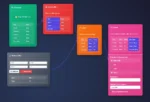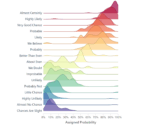Imagine being in a boardroom where complex data sets are presented through visuals brimming with insightful details and promising outcomes. The graphics are visually engaging, yet something critical is missing—explanatory, strategic text that contextualizes the data, turning impressive charts into actionable insights. Effective text integration in data visualization goes beyond just titles, labels, and annotations. It empowers decision-makers by making sophisticated analytics not only understandable but actionable. As data strategists and technical innovators at the intersection of analytics and user-centric innovation, we consistently find that the real value of data visualization comes from textual integration that tells the story behind the numbers.
Why Text Integration Matters in Data Visualization
Data visualization has transformed decision-making, bridge gaps between analytical complexity and intuitive understanding. However, visualizations alone frequently lack the necessary context decision-makers need to fully interpret and act on insights. Proper text integration goes beyond simple labels and titles—it offers narratives clearly connecting visual analytics with organizational goals.
When strategically integrated, text serves three key purposes in visualization: it directs attention to critical insights, clarifies the broader context, and ultimately drives better decisions. For instance, in our Power BI consulting services, we repeatedly demonstrate how embedding textual narratives within visualization dashboards turns static numbers into dynamic stories compelling enough for strategic actions. Clear textual elements help stakeholders quickly recognize patterns, understand why these trends matter, and inform actionable next steps.
Moreover, well-crafted narratives support data transparency and clarity, often essential in executive-level decision-making. As highlighted in our analysis of explainable computation graphs for transparent data transformations, transparency through textual content lets businesses build trust in their analytics and creates an environment for well-informed consensus. Textual integration thus becomes instrumental for informed collaboration, especially in environments where analytics impacts multiple stakeholders across different departments.
Elevating Data Narratives with Contextual Framing
The human brain is exceptionally adept at storytelling. Contextual framing through text integration within visualizations leverages this cognitive bias for more impactful communication. When data is presented alongside purposeful text, the viewer no longer sees isolated data points but perceives a story unfolding with clarity and precision.
For example, understanding a rise in user engagement metrics means little without textual context of recent system updates, marketing initiatives, or external market shifts. A good visualization strategy, thus, should incorporate textual explanations that link the visualization data directly with business activities and objectives. Consult our insights on causal inference frameworks to see how leveraging contextual text strengthens connections between causes and effects, giving decision-makers increased confidence in long-term strategic planning.
Additionally, textual framing around visual analytics not only communicates the “what” but also addresses the “why” behind specific data trends or anomalies. This kind of clear, explanatory narrative helps ensure data-driven decisions are strategic, targeted, and informed—using the rigor of analytics and the precision of visually communicated storytelling to drive measurable outcomes across business activities.
Embedding Interactive Textual Clarity in Complex Dashboards
Static text boxes alone are not sufficient for dynamic data visualization needs, especially within complex analytical dashboards. Modern, sophisticated decision-makers benefit from interactive textual components that dynamically adapt to changing data or context. Embedding interactive textual components into data dashboards helps leaders drill down into details that matter most for informed decision-making.
For instance, organizations using Power BI consulting services by Dev3lop leverage interactive tooltip texts, customizable explanations linked to data points, or conditional dialogues dependent on user selections. Just as explored in our guide on composable data analytics, we leverage building blocks approach to incorporate interactive textual summaries. By enabling users to select an analysis level that fits their business needs—whether strategic overview or granular deep dive—we empower informed, dynamic interaction with visualizations.
Interactive elements such as clickable explanatory textual tools provide contextually relevant information at a glance, allowing decision-makers to access precise explanations for complex insights. Especially pertinent in data-dense executive dashboards, interactive textual clarity ensures ease of use and maximizes the adoption rate and impact of analytics within organizations.
Integrating Textual Annotations for Precision and Increased Adoption
Precision is fundamental in data visualization. Incorporating accurate textual annotations around precise data points tangibly enhances understanding and fosters better organizational adoption. Misinterpretation or ambiguity can cause strategic misalignment; contextual and explanatory annotations resolve this by clearly defining metrics and offering definitive explanations behind analytical changes.
Within legacy or complex data systems, clarity through textual annotations can bridge modern visual analytics with established internal processes. As we discuss in-depth on our blog about innovating inside legacy systems without replacing them, annotations offer an effective path for organizations to modernize data usage incrementally without massive disruption. Not only do they minimize confusion, but they dramatically enhance communication across silos, making analytics more universally understandable and actionable.
Similarly, annotations also demystify elaborate computations, such as complex SQL queries. Users familiar with our guide on mastering precision with SQL WHERE clauses understand the value of precise textual annotations in explaining filtering logic in detailed charts or reports. Ensuring stakeholders clearly grasp the reasoning or conditions defining specific data selections greatly increases adoption rates and reliance on analytical outputs for busy decision-makers.
Augmenting Textual Clarity within Modern Analytics Platforms
Modern analytics platforms offer extensive features and flexibility for text integration, yet they often remain underutilized. Companies at the forefront of analytics integration—such as Austin-based technology leaders discussed in our article examining the growth driven by Austin’s tech industry in data analytics—are recognizing the strategic potential of robust, integrated textual content.
Leading platforms, including Power BI, Tableau, and visualization platforms leveraging innovations like those outlined in our discussion of the latest Canopy’s update, increasingly emphasize intuitive textual integration. By prioritizing carefully designed text—such as explanatory pop-ups, automated narrative generation, and integrated data-driven comments—leading-edge platforms empower users with clearer, richer insights and significantly smoother decision-making pathways.
Forward-thinking organizations are further blending contemporary visual analytics frameworks with strategic text integration initiatives, thereby offering clearer, more actionable reports, presentations, and dashboards. Aligning strategic objectives with clear visual and textual communication not only improves immediate decision-making but also positions the business for enhanced adaptability and innovation in rapidly evolving data ecosystems.
Unlocking Next-Level Data Visualization Through Strategic Text
Ultimately, while striking visuals capture immediate attention, strategic textual integration profoundly enhances usability, understanding, and adoption. Engaging readers through explanatory context, dynamic interactivity, precise annotation, and platform-specific integration optimizes visualization efficacy and turns insightful dashboards into vital business tools.
Whether you’re adapting sophisticated analytics services or modernizing legacy systems, advancing textual integration strategies within visual dashboards unlocks higher quality insights, decreased analytical deficiency, and heightened decision-making confidence. Data visualization maturity thus depends significantly upon text—its integration is no longer optional, but strategically essential. Understanding this breaks the barrier between superficial visual appeal and tangible strategic benefit.
Thank you for your support, follow DEV3LOPCOM, LLC on LinkedIn and YouTube.



















